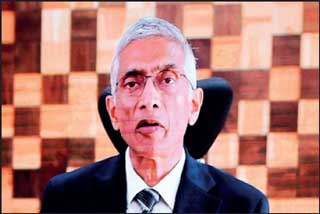Friday Dec 05, 2025
Friday Dec 05, 2025
Wednesday, 7 December 2022 00:24 - - {{hitsCtrl.values.hits}}
By Darshana Abayasingha
 |
| NITI Aayog CEO Parameswaran Iyer
|
With Sri Lanka envisaging to become a developed nation by 2048 and India looking to become a global economic powerhouse by 2047, the visions of both countries are complementary and could be directed
towards their mutual benefit.
Addressing the Inaugural Sessions of the Sri Lanka Economic Summit 2022, National Institution for Transforming India (NITI) CEO Parameswaran Iyer said Sri Lanka should take a fresh look at three main dimensions in its economic recovery.
These include revitalising and rationalising existing value chains, strengthening the service sector and tourism. He pointed to ample opportunity for Sri Lanka to leverage the proximity and markets of India.
“The enhanced economic and financial engagement during this year represents a fresh opportunity for India and Sri Lanka during this post-COVID phase. Going ahead, both the Indian Government and private sector will enhance ongoing cooperation with Sri Lanka, and focus on investment-led support especially in petroleum products and retail, hotels and tourism, telecommunications, manufacturing, real estate and banking and financial services.
“Sri Lanka has the potential to emerge a stronger and more resilient economy in coming years. Sri Lanka’s location is of significance as far as maritime security is concerned. It is in Sri Lanka’s interest to ensure freedom of navigation, safeguard maritime routes and have a rule-based international model,” Iyer said.
The NITI CEO said the foundations of India’s engagement with Sri Lanka is based on its precept of neighbourhood first in its foreign policy and complemented further by the Security and Growth for All in the Region (SAGAR) program. He stated this was reflected in India’s refusal to issue a travel advisory on Sri Lanka during the height of the political unrest earlier this year. “We believe principals cannot operate in isolation.”
With reference to Sri Lanka’s planned IMF engagement, Iyer touched on India’s economic crisis in the 90’s when the country’s reserves fell to just two weeks of imports, compounded by the then Gulf war and the breakup of the Soviet Union.
“The arrangement in 1991 was an opportunity for the government of India and the Reserve Bank of India to embark on a series of ongoing reforms. There were significant actions in trade liberalisation, capital reforms and tax reforms to ensure foreign capital inflows. India’s GDP is now $ 3.5 trillion and is the fifth largest economy in the world,” Iyer said, pointing to opportunities for Sri Lanka to conduct similar structural reform.
Digitalisation, production-linked incentive schemes and enhancements to the national infrastructure pipeline had created new avenues and economic opportunities in India, Iyer added.